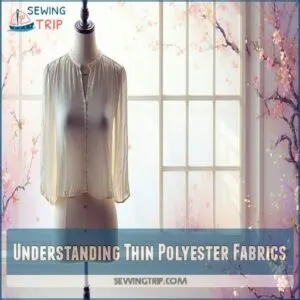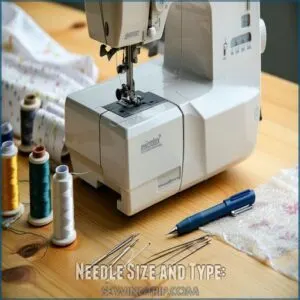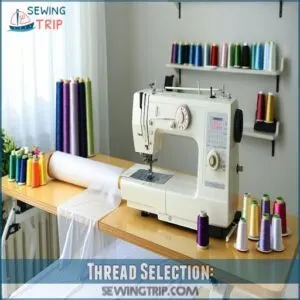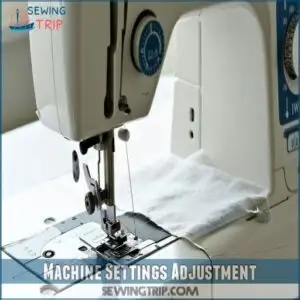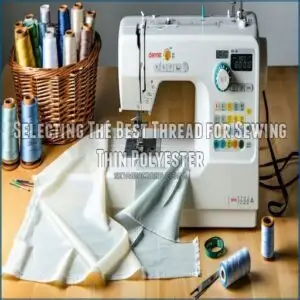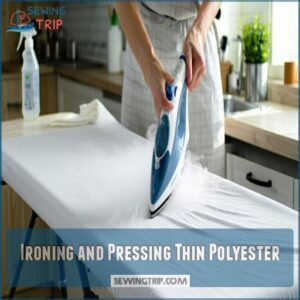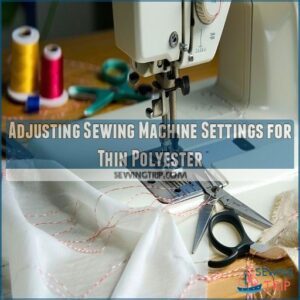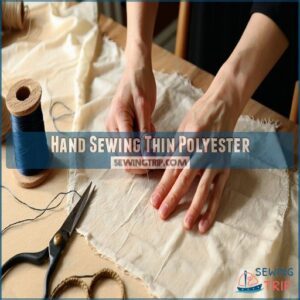This site is supported by our readers. We may earn a commission, at no cost to you, if you purchase through links.
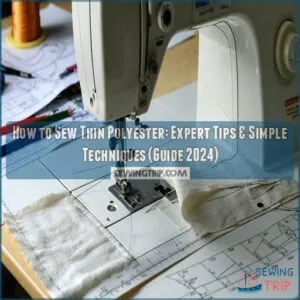
Set your machine’s stitch length between 1.5-2.0mm and reduce tension for smoother feeding. Match your fabric with polyester thread in a slightly darker shade, and consider using a walking foot attachment for even feeding.
For best results, adjust your foot pressure to light-medium and slightly lower those feed dogs to prevent bunching. French seams and rolled hems work beautifully on this fabric. Master these basics, and you’ll discover secrets for creating professional-looking garments.
Table Of Contents
- Key Takeaways
- Understanding Thin Polyester Fabrics
- Choosing The Right Needles for Thin Polyester
- Selecting The Best Thread for Sewing Thin Polyester
- Preparing Thin Polyester Fabric for Sewing
- Adjusting Sewing Machine Settings for Thin Polyester
- Sewing Techniques for Thin Polyester
- Hand Sewing Thin Polyester
- Troubleshooting Common Issues When Sewing Thin Polyester
- Tips for Sewing Thin Polyester With Stretch
- Final Tips and Considerations for Sewing Thin Polyester
- Frequently Asked Questions (FAQs)
- Conclusion
Key Takeaways
- You’ll need a size 60/8 or 70/10 ballpoint needle to prevent snags and skipped stitches when sewing thin polyester – switch needles after every 8 hours of use for best results.
- Set your machine’s stitch length between 1.5-2.0mm and reduce tension settings to 3-4 for smoother feeding, while keeping the presser foot pressure light to prevent fabric bunching.
- You’ll get the best results using polyester thread in a slightly darker shade than your fabric, and consider using a walking foot attachment to keep layers from shifting while sewing.
- Pre-wash your polyester in cool water and air dry it before sewing, then press on the synthetic setting using quick up-down motions with a pressing cloth to prevent shine marks and scorching.
Understanding Thin Polyester Fabrics
While thin polyester fabric might seem tricky at first, understanding its unique fabric characteristics makes all the difference. Think of it as dancing with silk’s lighter cousin – this synthetic fiber loves to flow and move, making it perfect for delicate garments where drape and movement matter.
You’ll find thin polyester everywhere, from flowy blouses to elegant curtains. Its fiber content gives it that signature lightweight feel while staying surprisingly durable. Unlike natural textile fibers, polyester fabric has a smooth, almost slippery surface that resists wrinkles and bounces back from washing.
To better understand thin polyester, learning about lightweight fabrics and their various applications is helpful. Care instructions are straightforward: gentle wash, low heat, and careful handling. Whether you’re working with sheer chiffon or lightweight linings, knowing your fabric types helps you master the material. Just remember – thin polyester might be synthetic, but it’s got personality all its own.
Choosing The Right Needles for Thin Polyester
Just like picking the perfect shoes for a marathon, choosing the right needle makes all the difference when working with thin polyester.
You’ll want to grab either a size 60/8 or 70/10 ballpoint needle to prevent those pesky snags and skipped stitches that can turn your sewing project into a frustrating mess.
Needle Size and Type:
For best results with most thin polyester fabrics, use a size 60/8 or 70/10 needle.
Choose a ballpoint needle for knits and a microtex needle for wovens, depending on your polyester type and fabric weight.
Needle sharpness is also important. A dull needle can snag or damage delicate polyester. Pro tip: Keep spare needles handy, as polyester can dull them quickly.
Thread Selection:
Now that you’ve got your needle sorted, let’s talk thread. Your best thread for polyester fabric is actually polyester thread itself. It glides smoothly through the material and matches the fabric’s stretch.
Look for high-quality thread weight that suits your project – lighter for delicate pieces, medium for everyday wear.
Color matching is key too – pick a shade slightly darker than your fabric as it’ll appear lighter when sewn.
Machine Settings Adjustment
Once you’ve picked your thread, it’s time to dial in those perfect sewing machine settings. Think of it like tuning a guitar – every element needs to work in harmony. Your stitch length, tension settings, and presser foot choice can make or break your polyester project.
- Set stitch length between 1.5-2.0mm for thin polyester
- Reduce tension settings to 3-4 for smoother feeding
- Adjust foot pressure to light-medium for less drag
- Keep feed dogs slightly lowered to prevent fabric bunching
Selecting The Best Thread for Sewing Thin Polyester
Just like matching your shoes to your belt, you’ll need to match your thread’s weight and elasticity to your fabric’s thickness to avoid those pesky puckers and snags that can turn your sewing project into a hot mess.
You’ll want to pick a thread that’s as slick and sturdy as your thin polyester fabric, with all-purpose polyester thread being your best friend for most projects.
Matching Thread Elasticity
Perfect thread elasticity makes all the difference when sewing thin polyester.
Your thread choice should match your fabric’s stretch to prevent puckering and broken seams.
Understanding thread production is essential for selecting the right thread type.
Here’s a quick guide to help you nail those perfect stitches.
| Thread Type | Stretch Level | Best Uses | Common Issues |
|---|---|---|---|
| All-purpose Polyester | Medium | Basic seams | Minor puckering |
| Woolly Nylon | High | Rolled hems | Cost |
| Textured Polyester | Low-Medium | Decorative | Tension problems |
| Stretch Thread | Very High | Swimwear | Threading difficulty |
Needle Selection Considerations
Now that you’ve got your thread elasticity sorted, let’s talk about your needle game.
Sharp needles specifically designed for thin polyester can make or break your project.
Choose between microtex needles for precise stitching or ballpoint needles to prevent fabric damage.
Your needle selection impacts thread tension and sewing accuracy, so pick a size 60/8 or 70/10 for best results.
Watch out for needle breakage by changing them regularly.
Techniques for Slippery Fabric
Slippery thin polyester can feel like trying to wrangle an eel on your sewing table.
To master fabric control methods and achieve smooth stitching, try these game-changing sewing aids:
- Sprinkle cornstarch lightly on your work surface to create natural fabric gripping without damaging the material
- Place tissue paper underneath while sewing sheer polyester to prevent sliding
- Use a walking foot attachment for even feeding and perfect polyester sewing techniques
Preparing Thin Polyester Fabric for Sewing
You’ll want to give your thin polyester fabric some TLC before it meets your sewing machine, starting with a gentle wash in cool water and air drying to prevent any sneaky shrinkage.
Once it’s dry, you’ll need to press it carefully on the synthetic setting, using quick up-down motions to smooth out those stubborn wrinkles without scorching your fabric, which will require some TLC.
Washing and Drying Thin Polyester
After choosing your thread, take time to properly prep your thin polyester – it’ll make your sewing journey much smoother. Start by testing color fastness on a small corner to avoid any bleeding surprises.
Pop your fabric into the washing machine using cold water and a gentle cycle, skipping fabric softening products that can leave pesky residues. To prevent fabric shrinkage later, tumble dry on low heat or lay flat to air dry. You’ll notice thin polyester dries pretty quickly compared to natural fibers.
If you’re working with printed polyester, turn it inside out before washing to keep those patterns looking fresh. Want a pro tip? Wash similar colors together – even colorfast fabrics can sometimes bleed in that first wash.
Once dry, your fabric’s ready for the next step: pressing.
Ironing and Pressing Thin Polyester
Now that your polyester’s clean, let’s talk ironing – it’s not as scary as you might think! Set your iron to the synthetic setting (usually marked with two dots) and test on a corner first.
You’ll want to keep the heat gentle with thin polyester fabric care to avoid those dreaded shiny marks. Use a pressing cloth between the iron and fabric for extra protection.
Quick, light movements work better than leaving the iron in one spot. Steam helps smooth out wrinkles without stressing the fibers – just hold the iron slightly above the fabric and let the steam do its magic.
Got stubborn creases? Try fabric smoothing with a spray bottle of water and your pressing tools. Remember: patience beats pressure when ironing thin polyester!
Adjusting Sewing Machine Settings for Thin Polyester
You’ll need to adjust your sewing machine settings just right to tame that tricky thin polyester that’s been giving you grief.
Getting the perfect stitch on thin polyester isn’t rocket science – it’s all about finding that sweet spot with your tension dial and switching to a smaller needle size.
Stitch Length and Tension
Getting your stitch length and tension right makes all the difference when sewing thin polyester. Think of it like tuning a guitar – you’ll need perfect thread control for those smooth, even seams. Understanding the polyester fabric properties is essential to achieve the desired results.
Here’s what works best for fabric stability:
- Set your stitch length between 1-1.5mm for delicate polyester
- Dial back your upper tension settings by 0.5-1 unit
- Test seam integrity on fabric scraps before tackling your project
- Watch for any thread loops or puckering as you sew
Start with a slower speed while you adjust your stitch regulation. Once you’ve found that sweet spot, you’ll see those professional-looking seams take shape.
Foot Pressure and Needle Choice
When sewing thin polyester, dialing in the right foot pressure makes all the difference between smooth sailing and a tangled mess. Start by reducing your pressure control to about 2 – just enough fabric grip to feed smoothly without stretching or puckering. Think of it like petting a cat: too much pressure and they’ll run, too little and they’ll slip away.
For needle selection, sharp needles are your best friend. Choose microtex needles in sizes 60/8 to 70/10 to pierce the fabric cleanly and prevent thread breakage. If you’re working with stretchy polyester blends, switch to a ballpoint needle to prevent snags. Using microtex needles can substantially improve the overall sewing experience with thin polyester fabrics.
Match your thread weight to your fabric – lightweight polyester thread usually works best. Test your stitch quality on scraps, adjusting both foot pressure and tension until you achieve perfectly balanced stitches.
Sewing Techniques for Thin Polyester
You’ll find that sewing thin polyester isn’t as tricky as it seems once you’ve got the right techniques down pat.
Whether you’re working on dancewear or a flowing dress, you’ll need specific methods for seam finishing, hemming, and handling those slippery fabrics that love to slide around your sewing table.
Seam Finishing Options
Now that you’ve got your machine dialed in, let’s explore your seam finishing options for those tricky thin polyesters. French seams work beautifully here – they’ll hide raw edges completely between two neat folds. For a professional touch, try seam binding or bias tape along the edges.
If you’ve got a serger, overlocking creates clean, durable finishes that won’t fray.
Don’t have fancy equipment? No worries! Simple folded hems work great too. For stretchy polyesters, consider lettuce edging or elastic finishes.
Remember to test your chosen method on scraps first to perfect your technique.
Hemming Thin Polyester
Mastering narrow hems on thin polyester starts with choosing the right technique. A rolled hem finish gives your projects that professional edge while preventing fraying.
Start by setting your machine with a 70/10 or 80/12 sharp needle and reducing foot pressure. For best results, create a double-needle hem by folding the fabric twice – first 1/8 inch, then another 1/8 inch.
Using fusible hem tape can help stabilize particularly tricky sections. Keep your stitch length short and even, and don’t forget to test your settings on a scrap piece first. Your thin polyester stitching will look store-bought in no time.
Dealing With Slippery Thin Polyester
Slippery polyester can test even seasoned sewists, but you’ve got this! Start by laying your fabric on a non-slip surface.
Pin generously with fine glass-head pins, and consider using spray starch for better fabric handling.
Need extra control? Sandwich those thin cuts between tissue paper layers.
For foolproof stitching on slippery surfaces, lower your presser foot pressure and try a walking foot—it’ll keep those layers moving smoothly together.
Hand Sewing Thin Polyester
You’ll find that hand sewing thin polyester isn’t as tricky as you might think, especially when you’re armed with the right needle and thread combo.
Whether you’re fixing a fallen hem or adding delicate details to your project, you’ll learn the essential hand-sewing techniques that’ll help you handle this slippery fabric like a pro.
Choosing The Right Needle and Thread
When you’re switching from machine to hand sewing thin polyester, picking the right needle and thread combo makes all the difference. You’ll want to grab these essentials:
- Sharp needles (sizes 60/8 to 70/10) slice through polyester fabric like butter, while ballpoint needles work magic on stretchy blends
- Fine polyester thread matches your fabric’s stretch and prevents puckering
- A needle threader saves your sanity with those tiny needle eyes
Using sharp sewing needles is vital for achieving professional results with thin polyester fabrics.
Let’s arm you with the perfect tools to achieve success with thin polyester fabrics!
Basic Hand Stitches for Thin Polyester
Your delicate polyester’s success with hand sewing starts with the basic running stitch – it’s like drawing a dotted line through butter.
Keep your stitches slightly longer than usual to allow for adjustments, and use a backstitch where you need extra strength.
For thin fabric sewing tips, grab a size 9 or 10 Milliner’s needle – they’re sharp enough to glide through without leaving holes.
When handling fabric, match your thread weight to your polyester’s thickness for invisible seams.
Skip bulky knots by weaving thread ends into seam allowances.
Finish edges with a neat overcast stitch to prevent fraying, and double-fold your hems before securing with tiny stitches.
Troubleshooting Common Issues When Sewing Thin Polyester
You’ll find that even the trickiest polyester problems (like puckering seams and damaged fabric) have simple fixes once you know what to look for.
Let’s tackle these common sewing headaches together, so you can transform that slippery, thin polyester into professional-looking garments without the frustration.
Puckering and Pulling
Stubborn seam puckers can turn your polyester project into a wrinkled mess.
The secret to smooth sewing lies in matching your tools to this tricky fabric.
Start with a size 60/8 or 70/10 needle – anything bigger risks fabric distortion and thread breakage.
Loosen your tension if you spot gathering, or tighten up if the fabric’s stretching between stitches.
For thin polyester fabric, dial down your stitch length to 1.5mm and adjust your presser foot pressure.
A walking foot can be your best friend here, keeping both layers moving together smoothly and preventing those pesky puckers from forming.
Ripped or Damaged Fabric
Dealing with ripped thin polyester can feel like trying to patch a cloud, but don’t worry – it’s fixable! Whether you’re facing small snags or major tears, there’s always a way to save your project.
Here’s what works best for fabric repair:
- Use tissue paper underneath while cutting to prevent initial damage and protect delicate fibers
- Apply iron-on interfacing before sewing to reinforce weak spots and prevent future tears
- Switch to a fresh 60/8 or 70/10 needle designed for delicate fabrics to minimize puncture damage
- Try hand-sewing with tiny backstitches for precise damage control in torn areas
- Keep fusible repair patches handy for quick fixes on small holes or snags
This approach helps to prevent and fix tears, ensuring your project turns out as desired with minimal damage.
Seam Slippage
Seam slippage haunts even experienced sewists when working with thin polyester. You’ll notice your fabric shifting and seams coming apart, especially in high-stress areas.
To boost seam security, start by applying fabric stabilization strips along seam lines. Choose the right needle for polyester fabric, reduce stitch length, and use a walking foot for better fabric grip.
If you’re still seeing thread breakage, try reinforcing your seams with a narrow zigzag stitch.
Tips for Sewing Thin Polyester With Stretch
You’ll love how stretchy polyester can dance through your sewing machine once you’ve got the right stretch needle and tension settings in place.
Whether you’re making workout wear or a flowy dress, these tips will help you tame that bouncy fabric without getting your seams in a twist.
Using a Stretch Needle
Got your stretch needle ready? You’ll want to pick up a pack of Schmetz stretch needles in sizes 70/10 or 80/12 – they’re perfect for sewing thin polyester without causing snags or runs.
Keep your sewing speed steady and let the needle do its work. For best results, pair your stretch needle with lightweight polyester thread that matches your fabric’s stretch factor.
It’s also essential to understand the role of stretch needles in preventing fabric damage. Remember to swap out your needle after about 8 hours of sewing time to prevent needle breakage and keep your stitches looking crisp.
A fresh needle makes all the difference when you’re working with delicate polyester fabrics.
Adjusting The Sewing Machine for Stretch
Now that you’ve got your stretch needle ready, let’s fine-tune your machine settings.
Set your machine tension slightly looser than normal and switch to stretch stitches—the lightning bolt or triple stretch stitch works great.
Keep your sewing speed slow and steady while adjusting the needle pressure.
If your machine has differential feed, set it between 1.0 and 1.5 to prevent wavy seams in your thin polyester.
For the best results, using the right sewing machine settings is vital when working with thin polyester fabrics.
Securing Seams and Hems for Stretch
Like a rubber band that needs just the right tension, securing seams on stretch polyester requires careful technique.
Start with seam reinforcement by backstitching at both ends, using a stretch stitch setting for flexibility. For hem stabilization, try a twin needle to create professional-looking parallel lines while maintaining elasticity.
When sewing delicate polyester, consider elastic binding or a rolled hem for a clean finish that won’t restrict movement. Fabric tensioning is essential – keep slight pressure while feeding the material, and test your stitches on scraps first to perfect your polyester sewing techniques.
Final Tips and Considerations for Sewing Thin Polyester
You’ll find these final tips essential for mastering thin polyester sewing, from choosing the right needle size to taming those tricky slippery fabrics.
Whether you’re working on a flowing dress or a delicate blouse, these expert techniques will help you handle polyester like a pro and achieve those perfectly smooth seams you’ve been dreaming about.
Needle Choice for Polyester
When sewing thin polyester, your needle choice makes all the difference between smooth sailing and fabric nightmares.
For delicate polyester fabrics, opt for sharp needles in sizes 60/8 or 70/10. You’ll want to switch needles after 8 hours of sewing to maintain clean punctures.
Universal needles work in a pinch, but microtex or sharp needles are your best bet for preventing snags and skipped stitches.
Ironing and Crease Removal
Through careful fabric smoothing, you’ll find that ironing thin polyester isn’t rocket science. Set your iron to synthetic setting – around 275°F – and use steam pressing sparingly.
For stubborn creases, try the press-and-lift technique instead of dragging the iron. A clean pressing cloth between the iron and fabric prevents shine marks.
Understanding polyester thread properties is essential for successful sewing outcomes. For wrinkle removal on delicate areas, hover the iron slightly above while steaming.
Tips for Slippery Fabric
Taming slippery fabric doesn’t have to drive you crazy. Try pinning your thin polyester to tissue paper – it’ll give you better fabric handling control and prevent those annoying shifts.
For extra stability, sprinkle cornstarch on your sewing surface or use a non-slip mat.
You’ll also want to adjust your tension control and use plenty of pins placed perpendicular to the seam line for better fabric stabilization.
Frequently Asked Questions (FAQs)
How do you sew with polyester fabric?
Practice makes perfect in polyester sewing!
Adjust your machine to a narrow zigzag stitch and set lower tension. Use a ballpoint needle. Don’t forget to stabilize thin fabrics with tissue paper underneath.
What should I consider when sewing polyester?
Use ballpoint needles and lower tension settings to prevent snags.
Adjust your stitch length and pressure foot for smooth, even stitches.
You’ll need sharp scissors and tissue paper for stabilizing.
How to sew a polyester dress by a sewing machine?
Start with cool water pre-washing and gentle pressing.
Set your machine to a straight stitch, adjust tension lower, and use a ballpoint needle.
You’ll need polyester thread and a walking foot for smooth seams.
How do I Make my polyester fabric smooth and flat?
Iron your polyester fabric on the synthetic setting while it’s slightly damp.
Lay it flat and press with gentle steam, using quick up-down motions.
Don’t drag the iron to prevent scorching or unwanted creases.
Is polyester fabric good for sewing?
Like a trusty sidekick, polyester‘s a fantastic fabric for sewing.
You’ll love its durability, wrinkle resistance, and versatility.
It’s perfect for beginners and pros alike, though you’ll need the right needle and settings.
How do you use a sewing machine with polyester thread?
Set your machine’s tension to medium-low, use a ballpoint needle, and adjust stitch length to 5mm.
You’ll want to sew slowly at first, making sure the thread flows smoothly through your machine’s guides.
Is a Walking Foot Necessary for Sewing With Polyester?
Perfectly practical polyester patterns don’t always demand a walking foot.
You’ll find it helpful for preventing puckering and slipping, but you can successfully sew with regular feet by adjusting pressure and using stabilizers.
Should I Use Temporary Spray Adhesive When Sewing With Polyester?
You can use temporary spray adhesive on polyester, but it’s not always necessary.
If you do, apply it lightly and test on a scrap first to avoid staining.
A walking foot works better for control.
Is Backstitching Necessary When Sewing With Polyester?
Backstitching is essential for polyester to prevent seams from unraveling.
It’s particularly vital at the beginning and end of each seam.
When working with delicate fabrics, reduce stitch length for secure reinforcement.
Can I Use a Double Needle Hem When Sewing With Polyester?
Double needle hemming works great with polyester, creating professional-looking parallel stitches.
Just be sure to adjust your tension and use matching thread.
It’s perfect for stretchy polyester fabrics and activewear pieces.
Conclusion
Did you know that 65% of sewists struggle with thin polyester fabrics?
Now that you’ve learned how to sew thin polyester effectively, you’ll be ready to tackle those slippery challenges with confidence.
Remember to keep your needle sharp, tension balanced, and stitches precise.
Whether you’re creating flowing dresses or delicate blouses, these techniques will help you achieve professional results.
With practice and patience, you’ll master the art of working with this versatile fabric and create beautiful garments you’ll love wearing.

